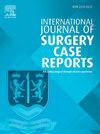Surgical management of the second cavernous lymphangioma in the tongue globally: A case report
IF 0.6
Q4 SURGERY
引用次数: 0
Abstract
Introduction and importance
Oral Lymphangioma is a rare benign tumor that arises from the lymphatic vessels in oral cavity. It is a development defect in the lymphatic system, which is less common than other types of vascular anomalies, and the incidence in the general population is very low, especially in the oral cavity. It typically presents as soft, painless swelling, often found on the tongue, lips or floor or the mouth. The lesions can vary in size and may have a translucent appearance, sometimes resembling a cyst.
Case presentation
A 13-year-old male complaint of congenital diffuse, painless swelling of the lateral side of the tongue. The swelling was soft and compressible and involved half of the tongue. Incisional biopsy from the lesion can confirm the diagnosis by showing dilated lymphatic vessels histologically.
Clinical discussion
Oral lymphangioma is a rare tumor found in the oral cavity, occurring at various sites but most commonly on the tongue. This often leads to macroglossia, presenting as a compressible, painless swelling that typically necessitates surgical excision when it causes functional issues.
Conclusion
Oral lymphangioma generally has a good prognosis, especially when treated appropriately. However, they can recur if not completely excised.
求助全文
约1分钟内获得全文
求助全文
来源期刊
CiteScore
1.10
自引率
0.00%
发文量
1116
审稿时长
46 days

 求助内容:
求助内容: 应助结果提醒方式:
应助结果提醒方式:


